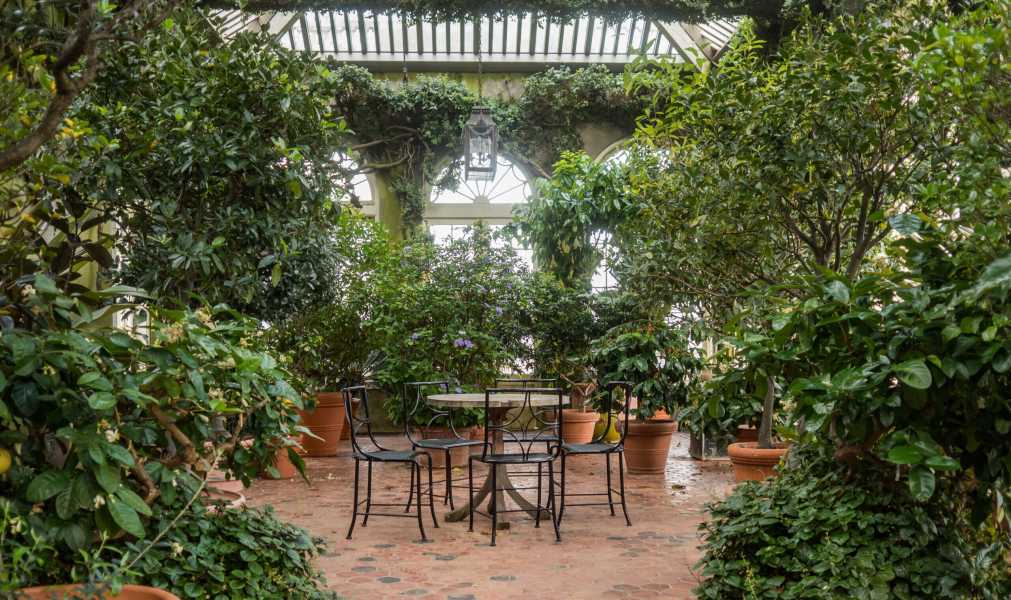Dumbarton Oaks, Washington, D.C.’s own rural manor house, opens again for the winter season.

Credit: image via Shutterstock
For the last few weeks, most people in Washington, D.C. have been feverishly counting down the days until the presidential election. Not me. As soon as the leaves began to turn, I was eagerly anticipating the opening of the winter season at Dumbarton Oaks Gardens. Now it has arrived. From November through March, the gates are thrown open to the public free of charge. And to my mind, these gardens are the most tranquil place in a city that does not value peace.
Dumbarton Oaks is the sort of oddity you don’t expect to find in Washington. It is an urban mansion on 16 acres of land and is primarily a research institution, owned and administered by Harvard University and specializing in the eclectic combination of Byzantine, Pre-Columbian, and Garden and Landscape Studies. To this end, the institution maintains an excellent library and runs a publishing imprint that puts out many otherwise rare books (including a six-volume bilingual edition of the Vulgate that is worth all $350 of its cover price). But the place is also a Georgetown neighborhood museum, devoted to displaying a collection of Byzantine and Pre-Columbian art—as well as other odds and ends—amassed by its former owners, Robert and Mildred Bliss, who donated the house and its grounds to Harvard in 1940.
All those icons, tapestries, and old altarpieces grouped together in a low-lit Colonial Revival house give the museum an otherworldly quality. The glassy pavilion housing the Mayan art, designed by the architect Philip Johnson, achieves a similar effect simply through discongruity with the rest of the grounds, and, for that matter, the rest of Georgetown. The museum is “a very unusual oasis of civilization in our savage, modern city,” wrote the city planner Carl Feiss in the mid-1960s, as he surveyed the mid-rise developments and highways which then as today obscured much of the capital’s eccentric charm. But to enter Dumbarton Oaks is to leave all that for another place entirely.
This effect is felt most strongly in the gardens. When the Blisses bought Dumbarton Oaks in 1920, Robert, a career diplomat who had been posted all over the world, had in mind the impossible dream of owning “a country house in the city.” To achieve it, he hired the landscape architect Beatrix Farrand (best known for her gardens on Mount Desert Island in Maine) to create the illusion of a country retreat. This is harder than it sounds. Most of the flora native to the D.C. area drop their leaves and decay in the fall. The bare branches of the trees and bushes lend winter in the city a certain beauty, but a severe one that constantly reminds you of your urban surroundings.
The Blisses required something different. “The gardens were to be for spring and autumn enjoyment and in winter to have perennial green in abundance,” Mildred wrote of Farrand’s work. “A swimming pool, tennis court, and brook completed the illusion of country life, while clever planting bordering the lawn screened the street on the south side and left the birds undisturbed.”
The rest of the effect was achieved through terracing, winding paths, and reflecting pools that made the grounds seem much larger—and much more wild—than they actually were. The most brilliant of Farrand’s touches, however, had nothing to do with the grounds but with how she framed the sky. At almost all points within the gardens the heavens appear endless, broken only by trees, giving the illusion that Dumbarton Oaks is the only house for miles.
“Never did Beatrix Farrand impose on the land an arbitrary concept,” Mildred wrote. “She ‘listened’ to the light and wind and grade of each area under study.”
Subscribe Today Get daily emails in your inbox Email Address:
Farrand probably did not know it, but in a small way she was recapturing what the land surrounding the mansion—and north of Georgetown generally—had looked like for much of the early nineteenth century. At that time, the area was rural, not even a suburb of the city. It wasn’t until after the Civil War that much of it was developed, and it would take many more decades—and the ascent of the United States as a global power—for it to become truly urban.
“The country has a beautifully picturesque appearance, and I have nowhere seen finer scenery than is composed by the Potomac and the woods and hills above it,” wrote Francis James Jackson, the British Ambassador to the United States during the Madison administration, of his drives through Northwest D.C. in 1809. “Yet it has a wild desolate air from being so scantily and rudely cultivated, and from want of population. The natives trouble themselves little about it; their thoughts are chiefly of tobacco, flour, shingles, and the news of the day.”
How little has changed from 1809 to now! Though the area in Northwest D.C. near Dumbarton Oaks is heavily populated, the interests of its inhabitants remain much the same—money, food, and gossip. Sometimes the weight of it all seems inescapable, especially in the frenzy leading up to a presidential election. What a blessing it is then that there is a retreat from that world, right within the city, where one can sit in the gardens of a rural fantasy, bathed in a pale winter light.
Sourse: theamericanconservative.com